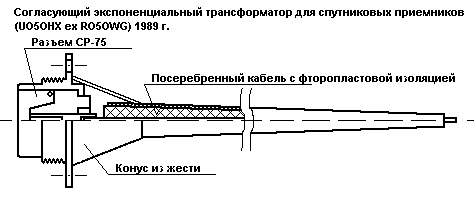The input impedance of bipolar transistors at microwave frequencies is the unit of Ω and has an inductive component. Therefore, with the direct connection of a coaxial cable with wave resistance of 75 Ohm in it is a standing wave.
If you have 10-20 cm silvered coaxial cable with Teflon insulation it is easy to make the exponential transformer. The insulation of this cable is made of PTFE ribbons wound around the Central wire. You need to remove the cable and unwinding PTFE ribbons (except the last). This insulation diameter will be at the output end of the transformer. Using a knife to cut ribbons converging "no" wedge. To wind the ribbon back, trying to get the exponential nature of the change in diameter of the cross section insulation length. Ribbons need not all! Pull the braid and shrink it tightly around the insulation. Lubricating braid flux LTI-120 and solder. Silver solder is gorgeous spreads. The resulting semi-rigid segment can be bent and rolled into the ring. Subsequent measurement of several samples of the transformer showed that the precision of the exponent and the cable length is not critical. It is only necessary to achieve a monotonic decrease of the cross section. The resulting transformer is soldered between the input connector and including a receiver unit.

For different variants of improvised V. C. blocks were received, increasing the gain of 4-6 dB! Significantly improved IPM in the feeder, and I reduced the noise input stage for improved matching at the input over the entire range of frequencies. I think this is a useful way to obtain further amplification of the microwave, applicable for many broadband devices.
Author: E. shoustikov, UO5OHX ex RO5OWG; Publication: www.shustikov.by.ru, www.cxem.net






